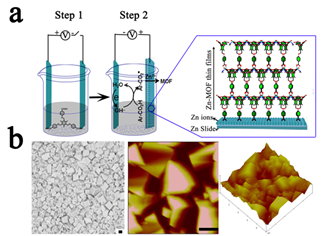Exploitation of new high-k materials that allow for a proportional increase in the gate thickness is very important for the design of gate dielectric materials.Currently, conventional silicon-based electronics have been dominating as main dielectric materials; however, their relatively low dielectric constant and large static power dissipation limit their practical application.
Recently, organic and inorganic hybrid materials have emerged as a new type of electronic material that combines the distinctive properties of the high-k of metal oxides and the flexibility of organic molecules. However, one of the major challenges in the fabrication of these films is the low compatibility of the organic and inorganic components, which typically leads to the generation of defects in the resulting films and a significant decrease in device performance.
Prof. CAO Rong and his research group from Fujian Institute of Research on the Structure of Matter (FJIRSM), Chinese Academy of Sciences (CAS) have developed a facile strategy by which interpenetrated crystalline metal-organic framework films were deposited onto conductive metal-plate anodes via in situ temperature-controlled electrochemical assembly. The prepared MOF thin films exhibit enhanced dielectric properties compared to their bulk powders MOFs. This work has been published as a communication in Nat. Commun.2016, 7, 1.
Based on a flexible ligand (1, 3, 5-tris[4-(carboxyphenyl)oxamethyl]-2, 4, 6-trimethylbenzene(H3TBTC)), Prof. CAO’s research team designed and synthesized a novel and interpenetrated MOF. Subsequently, they deposited the synthesized MOF onto conductive substrates as metal-organic frameworks thin film via electrochemical techniques.
As studied by scanning electron microscopy (SEM) and atomic force microscopy (AFM), they found that the nanostructure of the surface as well as the thickness and uniformity of the film are well controlled through regulation of the applied voltage and reaction time.
As the investigation of dielectric properties of MOF thin film and their bulk powders, the CAO’s research team also found that the dielectric constant of thin films was three times larger than their bulk powder MOFs.
Moreover, as shown by the experiment test and theoretical calculation of the typical MOFs such as MOF-123 and MOF-246 couples, the interpenetrated structure can improve the dielectric constant of thin films.
The measurement of mechanical properties and leakage current shows that the prepared thin films have a high mechanical properties and insulating properties.
This study demonstrates the successful implementation of the rational design of metal-organic framework thin films on conductive supports with high-performance dielectric properties.
This work was supported by the 973 Program, NSFC, "Strategic Priority Research Program" of the Chinese Academy of Sciences and Collaborative Innovation Center of Chemistry for Energy Materials (2011-iChEM).

Representation of MOF film assembly concepts and morphology study(Image by Prof. CAO's group)
Contact:
Prof. CAO Rong
Fujian Institute of Research on the Structure of Matter
http://english.fjirsm.cas.cn/
Chinese Academy of Sciences
Email: rcao@fjirsm.ac.cn